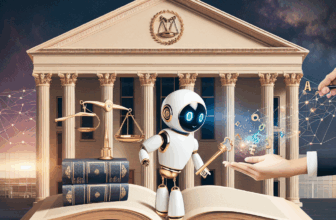Unlocking Efficiency: Optimizing Trust Tax Structures with AI in UK Probate
Table of Contents
- Introduction
- Understanding Trusts and Probates
- 2.1 What are Trusts?
- 2.2 The Probate Process
- The Intersection of Trusts and Taxation
- The Role of Artificial Intelligence in Optimizing Trusts
- Benefits of AI in Trust Tax Structures
- Challenges of Implementing AI
- Future Trends in AI and Trust Tax Structure Optimization
- Q&A and FAQs
- Resources
- Conclusion
- Disclaimer
1. Introduction
In an ever-evolving financial landscape, efficient management of asset distribution remains a paramount concern for beneficiaries, trustees, and estate planners alike. The integration of Artificial Intelligence (AI) into the complex framework of UK probate and trust taxation presents revolutionary potentials. This article examines the intersection of AI and trust tax structures, illustrating how optimization can lead to greater efficiency and better outcomes for all parties involved.
2. Understanding Trusts and Probates
2.1 What are Trusts?
Trusts are legally binding arrangements wherein one party, known as the trustee, holds property or assets for the benefit of another party, the beneficiary. The trust can be established during a person’s lifetime (inter vivos) or after death (testamentary).
Key Types of Trusts
- Living Trusts: Created during the lifetime of the settlor, providing immediate benefits.
- Testamentary Trusts: Activate upon the settlor’s death, directing how assets should be distributed.
- Charitable Trusts: Aimed at benefiting charitable organizations.
2.2 The Probate Process
Probate is the legal process through which a deceased person's estate is administered. It validates the will, appoints executors, and determines the tax obligations of the estate.
Steps in the Probate Process
- Application for Probate: Initiate the application in court to validate the will.
- Assessment of Estate: Inventory assets and liabilities for accurate evaluation.
- Payment of Debts and Taxes: Settlement of claims before asset distribution.
3. The Intersection of Trusts and Taxation
3.1 Taxation of Trusts in the UK
Trusts are subjected to various forms of taxation including Income Tax, Capital Gains Tax, and Inheritance Tax.
Income Tax and Trusts
Income generated by the trust's assets is typically subject to taxation. The rate may vary based on whether the income is distributed to beneficiaries.
Capital Gains Tax
When assets held in the trust are sold, any resultant gains may be liable for Capital Gains Tax, which is calculated based on the increase in value since the assets were acquired.
3.2 Common Tax Structures
- Bare Trusts: Minimal tax implications, simplest form of trust.
- Interest in Possession Trusts: Beneficiaries entitled to income, impacting tax obligations.
- Discretionary Trusts: Trustees have discretion in payments, also subject to tax complexities.
4. The Role of Artificial Intelligence in Optimizing Trusts
4.1 AI Technologies Used in Tax Structures
AI technologies such as Machine Learning, Natural Language Processing (NLP), and Robotic Process Automation (RPA) can streamline numerous processes associated with trusts.
Machine Learning
By analyzing historical data, machine learning algorithms can predict outcomes, identify potential tax liabilities, and ensure compliance.
Natural Language Processing
NLP can simplify the interpretation of legal documents, making the process more efficient and accessible for trustees and beneficiaries alike.
4.2 Case Studies
To illustrate AI's impact on trust taxation, several firms have adopted AI technologies leading to significant benefits:
- Case Study 1: A London-based law firm employed machine learning to predict compliance issues, resulting in a 30% reduction in late penalties.
- Case Study 2: An estate planning service used NLP for document analysis, reducing the time taken for legal assessments by over 40%.
5. Benefits of AI in Trust Tax Structures
5.1 Efficiency and Accuracy
The deployment of AI enhances efficiency by automating mundane tasks that consume time and resources.
Reducing Human Error
AI systems are less prone to the common errors associated with human input, leading to more accurate tax filings and compliance.
5.2 Cost Reduction
AI can drive significant cost savings by minimizing the need for extensive manpower.
Streamlined Processes
AI-powered processes can accomplish tasks faster and with less overhead, translating to fewer billable hours for advisors and higher satisfaction for clients.
6. Challenges of Implementing AI
6.1 Data Privacy and Security
The integration of AI raises concerns regarding data privacy and security, particularly since trust data includes sensitive financial information.
Steps for Compliance
- Implement data encryption solutions.
- Regularly train staff on cybersecurity protocols.
- Adopt robust data governance frameworks.
6.2 Regulatory Compliance
With the rapid evolution of technology, regulations may lag. Ensuring AI systems comply with existing legal frameworks remains a challenge.
Maintaining Compliance
Organizations must establish protocols to regularly review their AI systems against emerging regulations and standards.
7. Future Trends in AI and Trust Tax Structure Optimization
7.1 Emerging Technologies
Continual advancements in AI will shape the future landscape of trust tax structures. For instance, federated learning enables institutions to train algorithms without sharing sensitive data.
7.2 Changing Regulations
As AI technologies evolve, legislators will likely adjust existing tax laws and regulations to account for these innovations, affecting how trusts are managed.
8. Q&A and FAQs
Questions and Answers (Q&A)
Q: What is the main benefit of using AI in trusts?
A: The primary advantage includes increased efficiency and reduced operational costs associated with trust management.
Q: Are there any legal constraints when using AI for trust tax structures?
A: Yes, organizations must ensure compliance with data privacy laws and other regulations governing trust management.
FAQs
What types of trusts are commonly used in the UK?
- Bare Trusts
- Interest in Possession Trusts
- Discretionary Trusts
How is AI changing the probate process?
AI simplifies document handling, predicts compliance needs, and optimizes tax efficiency during probate.
9. Resources
| Source | Description | Link |
|---|---|---|
| HM Revenue & Customs (HMRC) | UK tax regulations and guidelines. | HMRC.gov.uk |
| The Law Society | Legal resources on trusts and probate. | LawSociety.org.uk |
| AI Now Institute | Research on AI and its implications in society. | AINowInstitute.org |
| The Office of Tax Simplification | Insights into the efficiency of taxation systems. | OTS.gov.uk |
10. Conclusion
The integration of AI into trust tax structures represents a significant leap towards optimizing efficiency within the UK probate system. As trust management becomes increasingly complex, the necessity for innovative solutions grows. Embracing AI technologies can lead to cost reductions, enhanced accuracy, and ultimately greater client satisfaction.
Future Trends
As technology continues to evolve, we can expect further refinements in legal frameworks, greater public acceptance of AI technologies, and improved regulatory measures to ensure compliance and data security.
11. Disclaimer
This article has been produced with the assistance of AI and is currently in beta testing. The content provided here is for informational purposes only and should not be construed as legal or financial advice. Readers should consult professionals before making any decisions related to trusts and probate.
This article provides a comprehensive overview of how AI can optimize trust tax structures within the UK probate landscape. For further study, consider diving deeper into case law surrounding trusts and keeping up with regulatory changes in AI technology.










